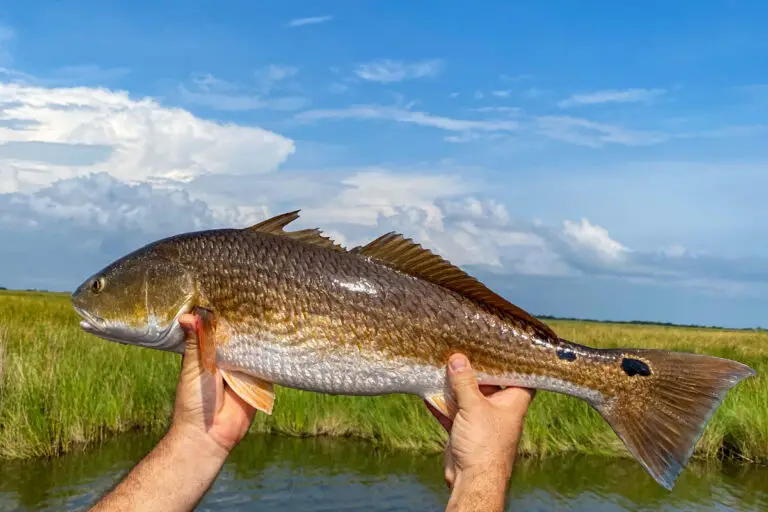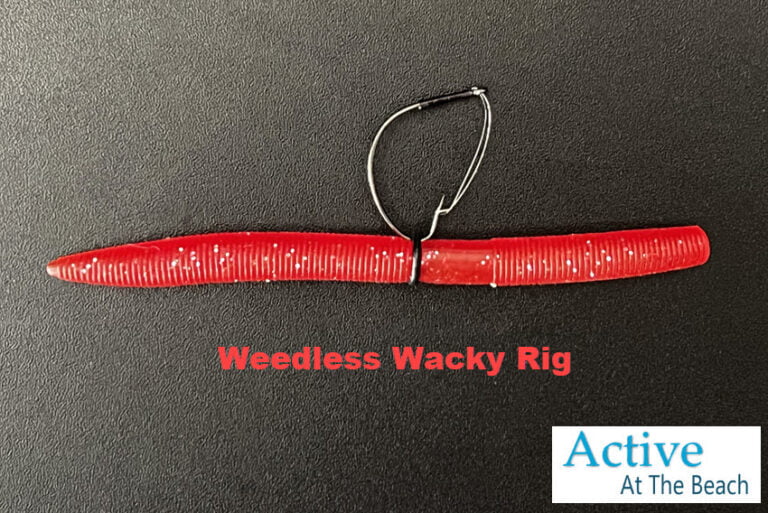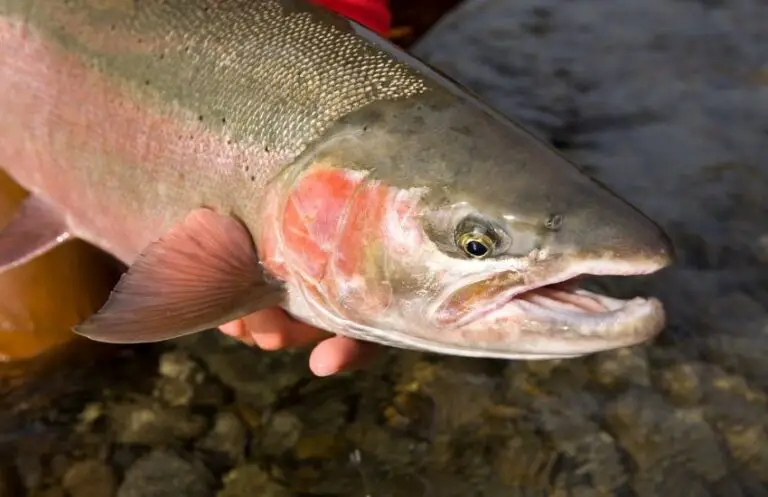The Fish Finder Rig: How To Master Best Rig For Surf Fishing
The Fish Finder Rig setup is the best surf fishing rig, perfect for catching fish in rough surf. These beach fishing rigs use a bottom presentation that moves freely and naturally with the current and bounces the bait to simulate injured baitfish. The sinker slides above a swivel on the main line.
Learn the steps to rig Fish Finder Rig setups for surf fishing, the best types of baits, and how to fish and present them on the water to catch fish.
In this article, you will see:
- An overview of the Fish Finder rigging and its setup
- How to set up your own Fish Finder rig
- The best hooks, weights, and lines for this setup
- Popular baits you can use for this setup
- How to hook the baits for this saltwater rig
- How to fish with the Fish Finder rig
- Where to fish with this rig
Let’s get started!
What Is the Fish Finder Rig?
The Fish Finder rig is considered the best surf fishing rig because it excels in open waters without much structure.
The fish finder rig makes it simple to take the big baits to the bottom, allowing you to catch more fish. When a Red drum or other big fish bites on the baitfish or artificial lures, it can swim freely without resistance.
This is due to the smart use of a sinker slide, which allows the bait to move freely without resistance from the sinker and provides the fish time to capture it in its mouth. Fish often don’t know that the rig is there until it’s too late and they have already been hooked. This makes the fish finder rig so effective for this game fish.
The sinker bounces the bait with stronger currents to simulate injured baitfish.
Explore Other Surf and Red Drum Fishing Rigs After Mastering the Fish Finder Rig
- Expand your rig-building skills by tying the Texas rig for pursuing red drum.
- Try the Senko Wacky Rig for a floating action when targeting bass. Here’s a step-by-step guide.
- Use the Carolina Rig to target the red drum, which can be particularly effective.
Guides to Salmon and Steelhead Fishing Techniques and Lures
- Check out our comprehensive guide to salmon lures for plunking, drifting, and casting for successful bank fishing.
- If you want to target steelhead through bank or bobber fishing, check out our guide to effective steelhead rigs and techniques for a successful fishing experience.
King Of The Surf Fishing Rigs
Fish finder rigs excel in surf fishing for the following reasons:
- It counteracts the current with a heavy pyramid in the front of the rig that keeps your presentation near the bottom, resisting the wave action and current. It allows the bait to move freely and naturally with the current, giving it a natural appearance for most predators to catch more fish.
- The sinker will drag your line to the bottom and cause the leader and bait to bounce up and down with the current, simulating a wounded or injured baitfish’s natural behavior.
- The third benefit of this rig is its plastic sinker slide, which allows the sinker to glide on the main line. When the fish takes the bait, they won’t feel the weight because of this, allowing them to get hooked before the fish realizes there’s a problem.
How To Setup Your Own Fish Finder Rig
For Typical Size Inshore Fish (20″ to 40″)
- Hook size 5/0 – Circle hook
- Barrel swivel or ball-bearing swivel
- 8 mm (1 or 2) – Red plastic beads
- Size 5 – Plastic sinker slide or metal snap swivel
- 3 oz – Pyramid or egg sinker
- 12-18″ – Leader line (#40 lbs fluorocarbon or monofilament)
- 50 lbs braided main line
For Typical Size Surf Fish (40″+)
- Hook size 8/0 – Circle hook
- Barrel swivel or ball-bearing swivel
- 8 mm – Red plastic bead
- Size 6 – Plastic sinker slide or metal snap swivel
- 6 oz – Pyramid or egg sinker
- 18-24″ – Leader line (#50 lbs fluorocarbon or monofilament)
- 50 lbs braided main line
Use These Steps To Set Up The Rig
- Thread the main line through the sinker slide
- Thread the red plastic bead onto your main line after the sinker slide
- Tie a barrel swivel to your main line using an “improved clinch knot”
- Tie the leader to the other end of the barrel swivel using an “improved clinch knot”
- Attach a hook to the end of your leader using an “improved clinch” knot
- Snap the pyramid sinker onto the sinker slide
Check out this terrific video from Take Me Fishing to see the Fish Finder Rig setup.
Fish Finder Rig Sinker Weight Size
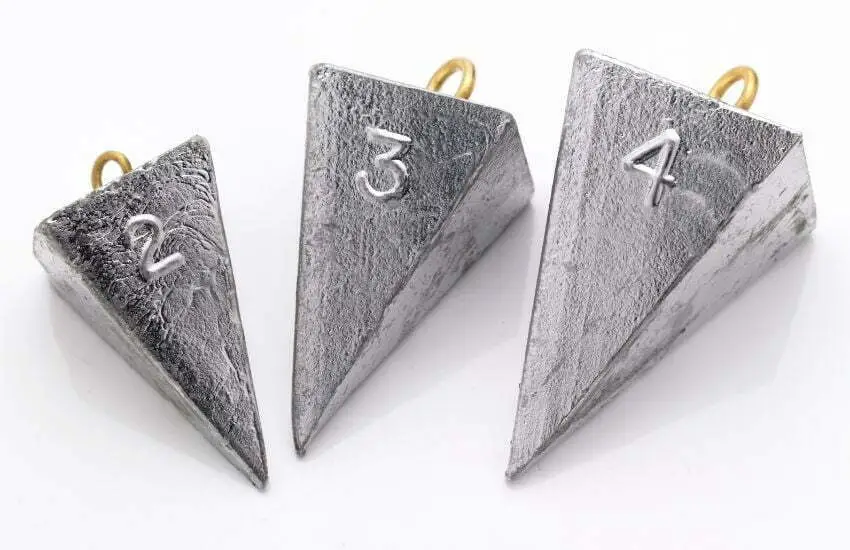
Sinkers for a surf fishing rig must be capable of gripping in a sandy environment. A pyramid sinker is ideal. The sinker occasionally bounces around, resulting in the rig’s well-known bait movement.
Sometimes the water is too rough, and most anglers want more control. So, deploying a Sputnik sinker with its long metal arms will keep your weight in place. Sputnik sinkers are also known as a grapple sinker. Egg sinkers are another good option.
Standard Sinker Weight Size For Marsh or Flats Fishing:
- Calm water: 2 oz
- Stronger current: 3 oz
Preferred Sinker Weight Size For Inshore Fishing:
- Calm water: 3 oz
- Stronger current: 4 oz
Standard Sinker Weight Size For Beach or Surf Fishing:
- Calm Waves: 4 oz
- Stronger Waves: 6 oz
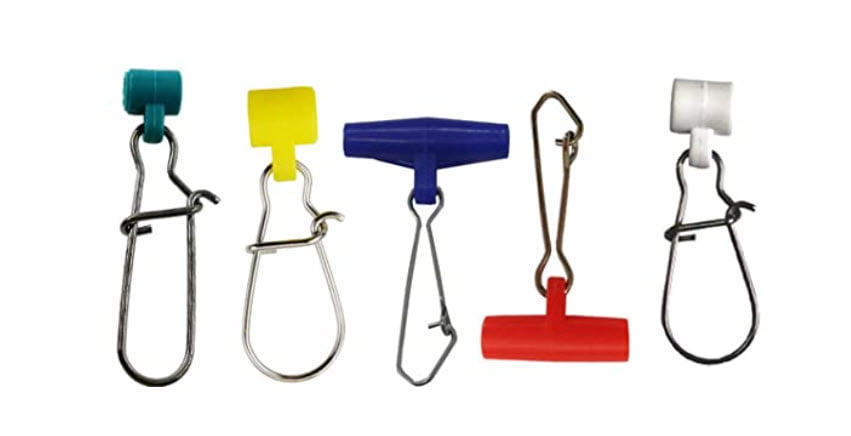
The Sinker Slide
The sinker slide is the secret sauce for this rig, one of the best surf fishing rigs. The plastic sinker slide allows the sinker to glide on the main line. When the fish takes the bait, they won’t feel the weight because of this, allowing them to get hooked before the fish realizes there’s a problem.
Sinker slides should be used with a plastic bead or bumper to protect the knot on your swivel.
Note: a sinker slide will cut into a braided line, so only use fluorocarbon or monofilament leaders when using a sinker slide.
Choose a sinker slide with the right size clip. The most commonly used types are:
- For a thin metal sinker loop, choose a slide with a thin clip rated for the sinker weight (pyramid and bell sinkers)
- For a thicker loop, choose a larger clip rated for sinker weight (bank sinker)

Pegging A Float
A foam float close to the bait is known as pegging a float to maintain a specific depth. The technique is simple and can be adjusted by changing the size of the foam float.
This is especially useful when crabs are snatching your bait. Simply raise the bait’s depth by several inches using this technique.
Fishing Line Choices For Your Rig
One of the most critical decisions when constructing your fishing rig is selecting the appropriate fishing line.
I like using a robust braided line for the main line, especially in brackish water when visibility is limited, and you won’t have to worry about being startled by surf fish. The braided line is durable, lightweight, and has no stretch, making it perfect for maintaining good line tension during fish hook-ups.
My leader lines are almost entirely of a fluorocarbon line attached directly to the main fishing line since you will present the fish finder rig at the bottom of the water column.
Note: a sinker slide will cut into a braided line, so only use fluorocarbon or monofilament leaders when using a sinker slide.
It also refracts light better, has less visibility in the water, and is more abrasive resistant. So, it is also better for fish with sharp teeth.
You will want a longer leader in the surf than inshore or marsh fishing. This will allow for more hook movement in the rougher water.
Standard Line For Marsh or Flats Fishing:
- Leader Length: 18″
- Line Strength: #20 lbs fluorocarbon
Preferred Line For Inshore Fishing:
- Leader Length: 18″
- Line Strength: #40 lbs fluorocarbon
Standard Line For Surf Fishing:
- Leader Length: 36″
- Line Strength: #40 lbs fluorocarbon

Circle Hooks: The Right Fish Finder Hook
The circle hook is a great choice if you’re actively catching and releasing fish or releasing smaller fish like a Juvenile redfish.
A circular hook is designed to only stick fish in the lip area and no further. The angle on the point is designed to only catch the fish when the hook comes out of its mouth, and the circle form catches on the lip.
Circle hooks are great for fish finder rigs because the rig’s free hook movement allows for maximum hook-ups, and the circle hook is easy on the mouth.
They’re most successful when lightly hooking a live bait when targeting saltwater species. They aren’t so effective when luring fishing or when a large bait that covers the hook is utilized.
The Most Frequently Used Hook Sizes
The size of the hooks you’ll need for your Fish Finder rig is determined by the size of the baits you’re throwing. The hook is measured from the eye of the hook to the pointed end.
Here are the popular hook sizes:
- 3/0 or 4/0 hooks for slot-size redfish or speckled trout when inshore or marshes
- 6/0 or 8/0 hook for larger bull reds and other game fish using 3″ cut baits
Ideally, you want to use the smallest hook you can get away with that is still large enough to hook the fish effectively when it strikes your bait.
Best Knot For Leader Line To Hook
These are the two recommended knots for a fish finder rig setup: the improved clinch knot and the double uni knot.
How To Tie The Improved Clinch Knot
Also known as the “fisherman’s knot,” the improved clinch knot is useful for tying off hooks and leaders. Learn how to tie the improved clinch knot here.
How To Tie A Double Uni Knot
The double uni knot is best for tying a monofilament to braid directly. Learn how to tie the double uni knot here.
The Best Fish Finder Baits
Natural bait and live bait work best on a fish finder rig as red drum and other big fish pick up the bait without feeling the sinker.
Live bait includes:
- Shrimp
- Crab
- Pinfish
- Mullet
Another technique for enticing fish is to use cut bait. Cut bait releases oils and blood, which attracts bull redfish at a distance. It’s a more powerful attractant than live bait in rough seas.
You may use two to four-inch pieces of bait from a fish called bunker or mullet. Frozen bait is also effective, but fresh is preferable, so make sure it’s chopped into little pieces.
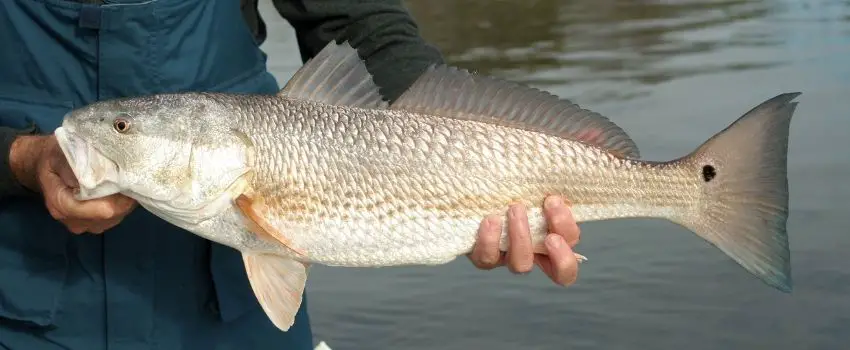
How To Hook A Fish Finder Rig
- For live bait, insert the barb into the top of the bait, away from the head or face, to prevent killing the baitfish.
- For cut bait, slide the strip through one end and loop the hook to pin through the other end of your bait. This will keep it on the hook through multiple casts.
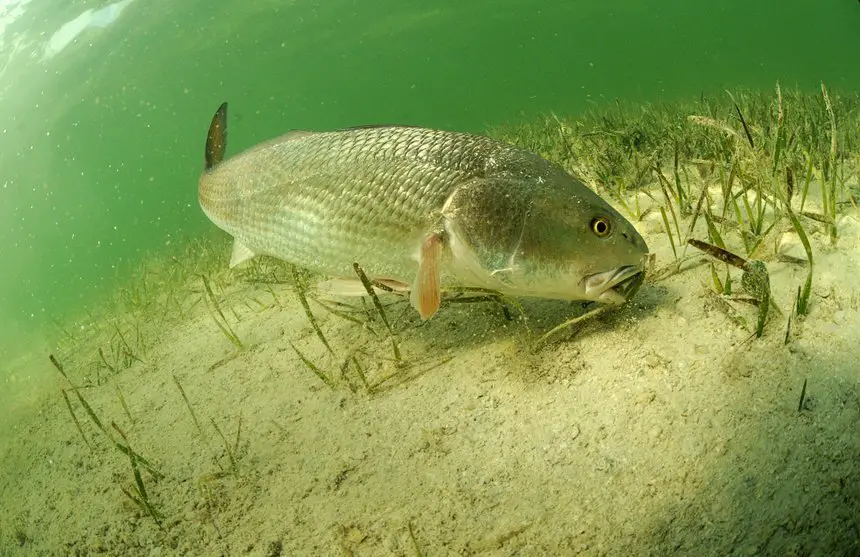
The Fish Finder Rig Setup For Surf Fishing
The Fish Finder Rig is primarily used in challenging conditions to attract fish in areas with little cover and minimal structure.
- Watch for crabs stealing your bait. Be prepared to peg a float to keep the bait off the bottom.
- The tide currents will bring your rig and bait toward shore, so you must reel in slowly to keep some tension on the line.
- Remember, you will not have to set the hook with the free-moving circle hook. A small tug will do while keeping tension on the line.
Find out more about What Tide is Best for Surf Fishing?
Setup The Fish Finder Rig For Inshore Fishing
Fishing inshore and the flats usually have weaker currents. This is ideal for fishing for redfish and spotted trout.

Presenting The Fish Finder Rig For Jetty Fishing
Jetties have structures that protrude from the beach and can capture schools of redfish.
These rocky areas strewn with huge boulders and rock jetties provide a great place to fish. They provide a secure refuge for a large number of crabs.
The current is responsible for taking the bait along the down-current side of the jetty or rock pile, but the red drum may be caught on any side of it in their pursuit of crabs.
Here I would change two things in my Fish Finder Rig:
- Knowing that my sinker will most likely get caught, I would use a much lighter sinker slide or sinker clip to break off if necessary
- Secure the hook tip in the bait, similar to a Texas or Carolina rig, to prevent hang-ups.
Summary
The Fish Finder Rig is a tried-and-true rig for surf fishing big saltwater game fish like redfish, striped bass, and speckled trout.
You were given a comprehensive guide for:
- An overview of the Fish Finder rigging and its setup
- How to set up your own Fish Finder rig
- The best hooks, weights, and lines for this setup
- Popular baits you can use for this setup
- How to hook the baits for this rig
- How to fish with the Fish Finder rig
- Where to fish with this rig



